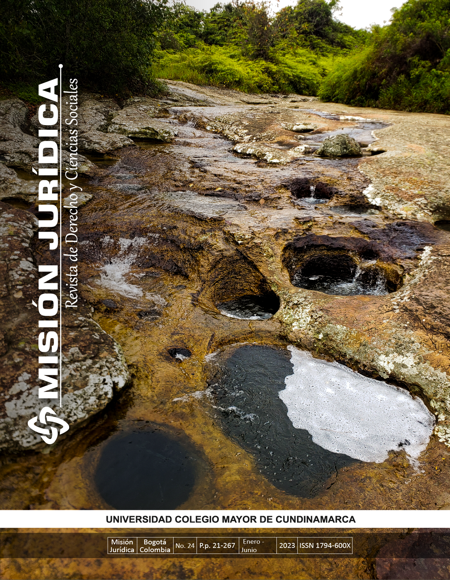Deterrent effect of speedy prosecution: a study in the Basque Country
Efecto disuasorio del enjuiciamiento rápido: un estudio en el País Vasco
COPYRIGHT PROVISIONS
Every papper included in the magazine can be reproduced whole or in part, provided that respect for its original content, the source is acknowledged and is used with non-commercial academic. Legal mission and its content is protected under a license Creative Commons Attribution-Noncommercial-

Misión Jurídica is distributed under a Creative Commons Attribution-NonCommercial-NoDerivar 4.0 International License.
Based on a work in http://unicolmayor.edu.co/publicaciones/index.php/mjuridica/index.
Permits that go beyond what is covered by this license can be found at http://unicolmayor.edu.co/publicaciones/index.php/mjuridica/index.
Show authors biography
All potentially criminal people are intimidated by the threat of a legal provision consisting of their prosecution and, where appropriate, the imposition of a sentence, without actually experiencing it personally; but those who have already committed a crime are also intimidated -in this case, palpably perceived- with their effective prosecution and their case, imposition and effective execution of the legally provided punishment. These are basically the postulates -referring to the concepts of general prevention and special prevention, respectively- of the theories of deterrence or prevention, whose origins go back to the works of the Classical School of Criminology; it established the parameters that define the effectiveness of the punishment: certainty, speed and severity. The first two (certainty, celerity) basically depend on the effectiveness of the police and the sped of the judicial procedure; the last (severity) of criminal law.
In the present work, starting from the configuration of the current police and penal regulatory framework in Spain, and based on a case study, an attempt will be made to verify the celerity factor, and more specifically, the speed of prosecution. In this sense, the recidivism of subjects investigated for the minor crime of flagrant theft (Art. 234.2 and 3 of the Penal Code) will be analyzed, distinguishing that they have been prosecuted in application of the procedure for a minor crime popularly known as "Quick Trial" (strictly legal-procedural proceedings, Proceedings for minor offenses for immediate prosecution, ex Arts 962 to 964 LECrim) where the punishment is imposed by the Investigating Courts in a matter of hours or days, or by the procedure for minor offenses for ordinary prosecution (ex Art. 965 LECrim) which means postponing the issuance of the punishment for weeks or even months.
In other words, it would be a matter of unraveling and reaching a conclusion about whether the specific efficacy of the punishment on the offender is mediated by the celerity with which it is prosecuted through the circumstance of verifying its subsequent recidivism, also assessing the influence of personal factors related to their age, sex and origin.
Article visits 173 | PDF visits 181
Downloads
- Bautista, R y Miró, F. (2015). ¿Por qué algunos siempre incumplen? Infractores y multi-infractores en seguridad vial. https://raco.cat/index.php/InDret/article/view/304387/394066
- Bautista, R., y Miró, F. (2013). ¿Por qué cumplimos las normas penales? Sobre la disuasión en materia de seguridad vial. https://raco.cat/index.php/InDret/article/view/270193
- Beccaria, C. (1764). Tratado de los delitos y las penas. Maxtor.
- Berdugo, I. (2016). Lección 2. Las normas penales: estructura y contenido. Curso de Derecho Penal. Parte General (págs. 23-43). https://elibro-net.universidadviu.idm.oclc.org/es/ereader/universidadviu/59964
- Bolaños, M., y Valero, R. (2009). Consideraciones Teóricas para el abordaje empírico de la disuasión penal. Revista Cenipec. https://biblat.unam.mx/es/revista/revista-cenipec/articulo/consideraciones-teoricas-para-el-abordaje-empirico-de-la-disuasion-penal
- Cardenal, S. (2015). ¿Eficacia preventiva general intimidatoria de la pena? Consecuencias para la decisión sobre la suspensión de su ejecución. Revista electrónica de la ciencia penal y criminología. http://criminet.ugr.es/recpc/17/recpc17-18.pdf
- Circular 1 de 2015 de la Fiscalía General del Estado, sobre pautas para el ejercicio de la acción penal en relación con los delitos leves tras la reforma penal operada por la Ley Orgánica 1/2015. https://www.boe.es/buscar/abrir_fiscalia.php?id=FIS-C-2015-00001.pdf
- Consejo General del Poder Judicial (2020). Estimación de los tiempos medios de duración de los procedimientos judiciales. https://www.poderjudicial.es/cgpj/es/Temas/Transparencia/Estimacion-de-los-tiempos-medios-de-duracion-de-los-procedimientos-judiciales/
- Cury, E. (1992). Derecho Penal, Parte General, T. II. Editorial Jurídica de Chile.
- De la Cuesta, P (2007). Conocimiento de la ilicitud. El conocimiento normativo en una teoría de la racionalidad limitada. https://vlex.es/vid/conocimiento-normativo-racionalidad-39050368
- Fundación Paz Ciudadana (2016). Análisis del Proyecto de Agenda Corta Antidelincuencia. Proyecto de ley que facilita la aplicación efectiva de las penas establecidas para los delitos de robo, hurto y receptación y mejora la persecución penal en dichos delitos (Boletín N° 9.885-07). https://pazciudadana.cl/biblioteca/prevencion-del-delito/analisis-del-proyecto-de-agenda-corta-anti-delincuencia/
- Ley 38 de 2002, de reforma parcial de la Ley de Enjuiciamiento Criminal, sobre procedimiento para el enjuiciamiento rápido e inmediato de determinados delitos y faltas, y de modificación del procedimiento abreviado. 24 de octubre de 2002. D.O. Nº 258. https://www.boe.es/eli/es/l/2002/10/24/38
- Nagin, D. S. N. (2013). La disuasión en el siglo XXI. Seguridad ciudadana. Lecturas fundamentales (pp. 345- 399). CAF. https://scioteca.caf.com/bitstream/handle/123456789/1433/Seguridad%20ciudadana-lecciones%20fundamentales.pdf
- Patiño Ortega, M. (2016). Teoría de la elección racional de Cornish y Clarke. https://crimipedia.umh.es/topics/teoria-de-la-eleccion-racional-de-cornish-y-clarke/
- Paternoster, R (2010). How much do really know about criminal deterrence? Journal of Criminal Law and Criminilogy. https://scholarlycommons.law.northwestern.edu/cgi/viewcontent.cgi?article=7363&context=jclc
- Pucci, F, Rojido, E, Trajtenberg, N. y Vigna, A. (2009). Explicaciones de la no reincidencia delictiva. El Uruguay desde la sociología VII.
- Redondo, S. y Garrido, V. (2013). Principios de Criminología. Tirant Lo Blanch.
- Robinson, P.H. (2012). Principios distributivos del Derecho Penal: a quien debe sancionarse y en qué medida. Marcial Pons.
- Rubio, P. A. (2017). Teoría de la pena y consecuencias jurídicas del delito. Tirant Lo Blanch.
- Trajtenberg, N. y Aloisio, C. (2016). La racionalidad en las teorías criminológicas contemporáneas. https://perso.unifr.ch/derechopenal/assets/files/articulos/a_20160908_03.pdf
- Zambrano, A. (2019). Derecho general. Parte General. Corporación de estudios y publicaciones. https://elibro-net.universidadviu.idm.oclc.org/es/ereader/universidadviu/123926















